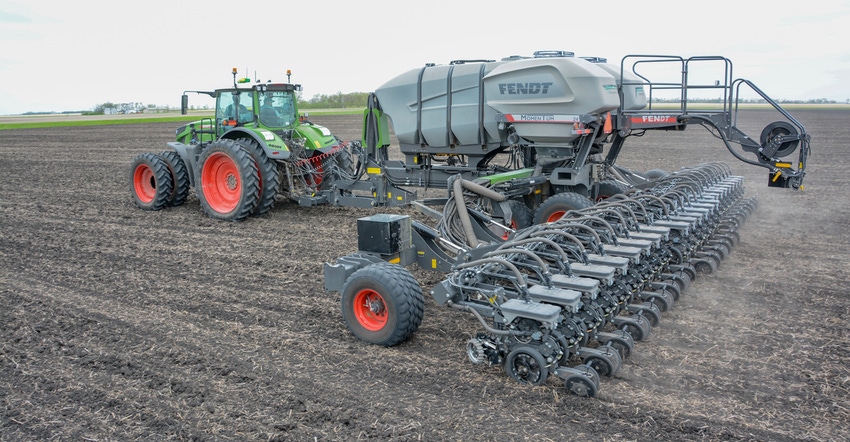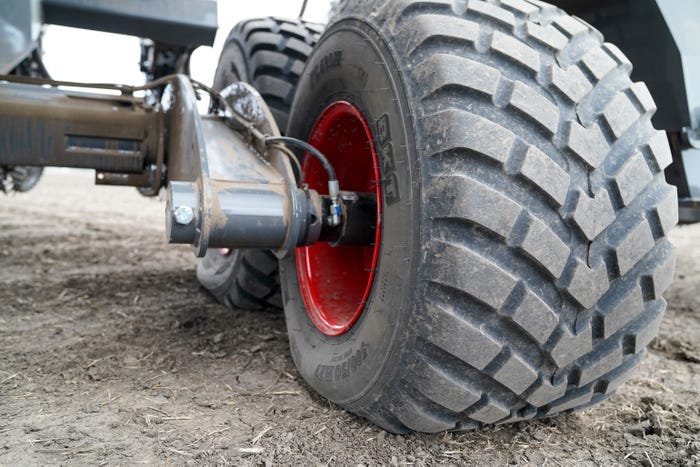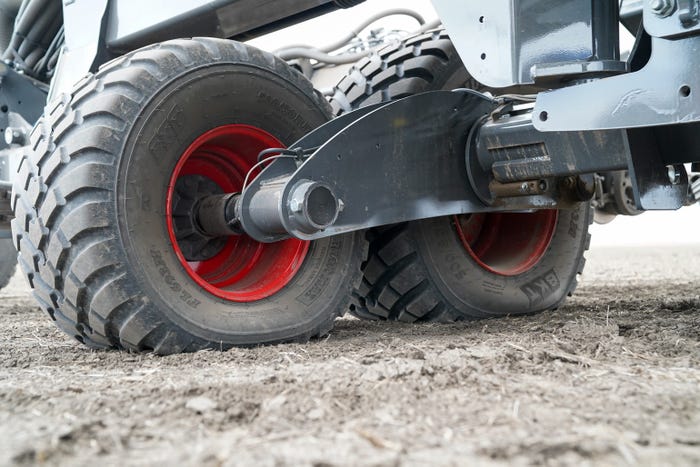
Some farmers in North Dakota and South Dakota got a look at Agco Corp.’s new Fendt Momentum planter this spring. The company put the planter through its paces planting corn, soybeans, sugarbeets and pinto, black and kidney beans on a half dozen farms near Sioux Falls and Fargo.
“I’ve been very impressed,” says Steve Pranke, an Agco product specialist from Canton, S.D., who ran the planter for about six weeks this spring. “I have operated about every planter there is and this one is phenomenal.”
Tech highlights
There’s some interesting design concepts and new technology on the Fendt planter, including:
Two toolbars. The 10-by-10-inch primary toolbar is stationary (no lifting wheel modules) and carries the bulk fill seed and fertilizer tanks. It also acts as the rolling chassis that supports the secondary toolbar as it folds around the primary toolbar for transport.
The secondary toolbar consists of three or five independent, intelligent sections depending on the width that carry the row units. They adjust automatically to ensure the row units are always properly engaged with the soil and place seed at the ideal seeding depth.
The planter’s sensor-controlled hydraulic system automatically adjusts the height of each toolbar section while monitoring the angle of the row-unit parallel arms, keeping the arms level and the row units properly engaged with the soil as ground conditions and terrain change.
 TWO TOOLBARS: The Momentum planter has two toolbars. The primary bar carries the weight of the seed and fertilizer tanks. The row units hang on the secondary toolbar. There enough room on the bar that the space spacing can be narrowed down to 15-inches.
TWO TOOLBARS: The Momentum planter has two toolbars. The primary bar carries the weight of the seed and fertilizer tanks. The row units hang on the secondary toolbar. There enough room on the bar that the space spacing can be narrowed down to 15-inches.

Agco has applied for a patent for the system.
Row unit vertical travel range. Each row unit has a vertical travel range of 68 inches. The planter flexes so much that it can wrap itself over the top of a terrace and down into the lowest point, putting each row unit in the best possible position for optimal row-cleaning, downforce, furrow-forming, seed placement and closing. This feature makes changing direction to plant terraces a thing of the past.
In-line tandem wheels. Instead of tandem dual wheels, the center transport system has in-line tandem wheels positioned ahead of the row units. This placement accommodates 15-inch row unit spacing and eliminates pinch rows typically created by dual-wheel transport systems.
Anti-soil compaction tools. The 19-inch-wide VF (very high flexion) tires and automatic central tire inflation system limit soil compaction that comes with the added weight of central-fill seed and fertilizer tanks. In addition, the in-line tandem wheels follow the track of the tractor tires, limiting compaction.
This transport system also provides the flotation advantage of tracks and the high road speed of tires. Wing wheels can be positioned at the end of each wing to run outside the last row unit. This placement puts the wing wheels in the same path on each pass through the field, reducing overall compaction without sacrificing row numbers or spacing.
The VF tires have a large footprint and carry 40% more weight at the same inflation as conventional radial tires.
 FLEXION TIRES: Air pressure on the VF (very high flexion) tires can be reduces so that the tires perform like tracks.
FLEXION TIRES: Air pressure on the VF (very high flexion) tires can be reduces so that the tires perform like tracks.

Central tire inflation. Like Fendt tractors, the planter can be equipped with a central tire inflation system that automatically adjusts tire pressures from the roadway to the field, deflating the tires to a pre-set low of 15 psi as the wings unfold. To reduce yield-robbing soil compaction during planting, the Load Logic system will automatically adjust tire pressure up or down, compensating for the fluctuating weight of the planter as seed and fertilizer are used or replenished.
The operator can select from two automated Load Logic weight management modes. The Load Balance mode equalizes the weight across the planter, adjusting based on weight and speed information from sensors on each axle. The Controlled Traffic mode transfers the bulk of the weight to the center section of the planter, reducing the weight on the soil from the wing tires.
By concentrating the planter's weight in the tracks made by the tractor, soil compaction is limited. This mode works well for growers who maintain tram lines and use the same path for each field operation. Research has shown 80% of compaction at planting is created by the tractor.
Side-by-side tests
In the Fargo area, the Momentum planter was seeding side-by-side with other planters. Growers may be invited to a crop tour in August to see the difference between planters in stands, soil compaction and other factors. At press time, details of the tour had not been announced due to COVID-19 uncertainty.
For more information about the planter, see our slideshow from January. Also, visit fendt.com, follow @Fendt_NA on Twitter; search #FendtMomentum; or contact Fendt dealers Butler Machinery Co., Fargo, N.D., or Ziegler Ag Equipment, Minneapolis.
Watch Agco’s Momentum planter walk-around video below for a closer look at the planter.
About the Author(s)
You May Also Like






